E-Archive
Science Update
in Vol. 15 - November Issue - Year 2014
Wire Bristle Impacting as an Alternative to Shot Peening for Improving Fatigue Performance
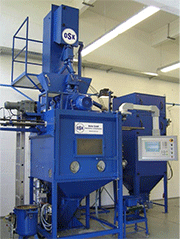
Figure. 1: Shot peening machine

Figure 2: Peening procedure

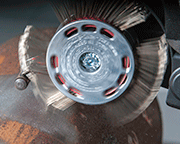
Figure 3: Bristle Blaster

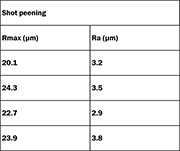
Table 1: Roughness values after wire bristle impacting and after shot peening

Figure 4: Change in curvature of Almen strips A as a function of exposure time
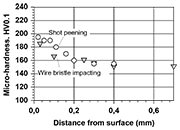
Figure 5: Micro-hardness-depth profiles
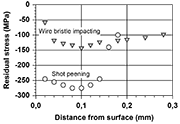
Figure 6: Residual stress profiles
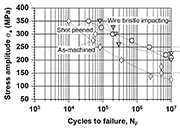
Figure 7: S-N curves in rotating beam loading (R = -1)
Mechanical surface treatments such as shot peening, deep rolling and laser shock peening are well known to improve fatigue performance of metallic components. This improvement is often explained by the process-induced residual compressive stresses that reduce the propagation rate of surface cracks. Wire bristle impacting by rotating steel brushes is typically applied for descaling and deburring by which oxide layers are removed from heat treated steel components.
Up to now, wire bristle impacting has been almost exclusively utilized for surface cleaning and preparation of surfaces for coating and/or painting. The effect of wire bristle impacting on possible surface strengthening and resulting fatigue strength enhancement has hardly been taken into consideration.
In the present investigation, the effects of wire bristle impacting on the surface and surface layer properties such as surface roughness, work hardening and residual stress profiles are compared with shot peening effects on Al2024-T4. In addition, the high cycle fatigue performance of wire bristle impacted and shot peened conditions are compared and contrasted.
For shot peening, a universal peening machine Gravi 2000 of OSK Kiefer, Oppurg, was used (Fig. 1). Figure 2 illustrates the peening process on a fatigue specimen.
Spherically conditioned cut wire SCCW 14 was used.
Wire bristle impacting was utilized by an electrically driven system named Bristle Blaster® from Monti, Hennef (Fig. 3). The brushes were made of high strength spring steels.
Before treating the fatigue specimens, the influence of the exposure time in wire bristle impacting as well as in shot peening on the curvature development of Almen strips was determined. Results are illustrated in Figure 4.
Both treatments led to marked increases in curvature of the used Almen strips type A already after short exposure times. As seen in Figure 4, the resulting curvatures after 300 s are about the same amounting to 0,15 mmA independent of the particular surface treatment.
A comparison of the roughness values measured by a perthometer is given in Table 1.
It can be seen that the roughness values are comparable. Wire bristle impacting gives rise to a maximum hardness value of slightly more than 180 HV0 1 (Fig. 5).
The penetration depth of increased hardness amounts to about 0.2 mm. As shown in Figure 5, the micro-hardness distribution after shot peening is very similar.
As shown in Figure 6, both surface treatments induce residual compressive stresses as measured by the hole drilling method. However, the magnitude of the residual compressive stresses after shot peening is markedly higher than after wire bristle impacting.
The results of the rotating beam fatigue tests are depicted in Figure 7. As opposed to the as- turned reference condition, both surface treatments result in an enormous enhancement of the 107 cycles fatigue strength from about 125 MPa to more than 200 MPa (Fig. 7). Remarkably, the fatigue strengths after shot peening and wire bristle impacting are very similar although the residual compressive stresses are rather different (Fig. 6).
Summary
Wire bristle impacting of precipitation hardened aluminum alloy Al2024-T4 leads to surface and surface layer properties surface roughness and microhardness-depth profiles very similar to conventional shot peening. The enhancement of the HCF strength due to wire bristle impacting can be as marked as due to shot peening although the shot peening induced residual compressive stresses are much higher.
References
[1] S. Hirose, H. Moriya, S. Harada and A. Yamada
Combined Surface Treatment by Shot Peening and Power Brushing, ICSP 2 (H.O. Fuchs, Ed.), American Shot Peening Society (1984) 50.
{2] M. Wollmann und L. Wagner
Kugelstrahlen als Verfahren zur Lebensdauererhöhung von Leichtmetallen. DIALOG Materialwissenschaften und Werkstofftechnik, DGM (2013) 112.
[3] T. Ludian and L. Wagner
Effect of age-hardening conditions on high cycle fatigue performance of mechanically surface treated Al2024. Materials Science and Engineering, A468 (2007) 210.
[4] T. Ludian and L. Wagner
Fatigue Strength Improvements in Various Aluminum Alloys after Shot Peening, MFN (2006) 46.
[5] T. Ludian and L. Wagner
Effect of Age-Hardening Condition on HCF Performance of Mechanically Surface Treated Al2024 (L. Shaw, J. Larsen and P. Liaw, eds.) Fatigue and Fracture of Traditional and Advanced Materials, The McEvily Symposium, Fatigue and Fracture of Traditional and Advanced Materials, TMS 2006.
For Information:
1Institute of Materials Science and Engineering, TU Clausthal, Agricolastr. 6, 38678 Clausthal-Zellerfeld, Germany
2MONTI - Werkzeuge GmbH, Reisertstr. 21, 53773 Hennef, Germany
L.Wagner1, M.Wollmann1, C. Becker1, V. Jannaschk2, A.Montabaur2



























